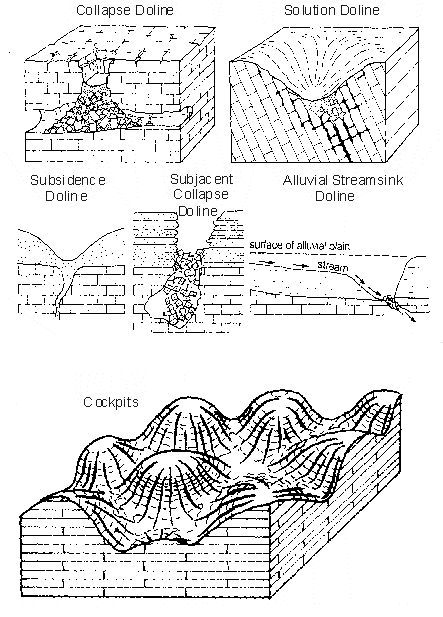
Kansas Geological Survey
Open-file Report 2001-55

|
|
Kansas Geological Survey Open-file Report 2001-55 |
Karst is the product of subaerial exposure of carbonate rocks. Karst is recognized by features produced by dissolution, precipitiation, erosion, sedimentation, and collapse in a variety of surface and subsurface landforms (Esteban and Wilson, 1993). Sweeting (1973) describes karst as a solution controlled landform type, characterized by an exclusive surface morphology, subsurface drainage, and collapse features. These karst features occur at a wide range of scales, from landforms and drainage patterns covering many square kilometers, to cement and internal sediment textures observed in thin section.
To date there is very little information on the nature of karst development in Kansas beyond clear evidence of extensive stratigraphic truncation and solution-enhanced fracture networks (Franseen et al., 1995). Detailed regional and local mapping of the erosional Arbuckle surface using abundant well data provides a basis for imaging this buried surface.
Dolines and Cockpits
Dolines are closed hollows of small or moderate dimensions. Dolines can be cone or bowl shaped with circular or elliptical plan, and are the most characteristic features of karst landscapes. Each closed depression has an associated catchment area from which precipitation is captured and focused as internal runoff into the drain of the depression. Jennings (1985) recognizes five major classes of dolines. The two main types affecting the Arbuckle carbonates are solution and collapse dolines.
Cockpits are star-shaped depressions with a slightly concave floor. The closed depressions is cockpit karst landscapes behave as small river basins, characterized by intermittent and centripetally directed flow down poorly developed channels (Williams, 1972). Cockpit karst landscapes are visually dominated by the residual hillsthat occur between a system of closed depressions and these topographic divides can be polygonal in shape.

|
| Schematic represention of five types of dolines, and cockpit karst, modified from Jennings (1985). |
|
|
e-mail : webadmin@kgs.ku.edu
Last updated January 2002
http://www.kgs.ku.edu/PRS/publication/OFR2001-55/P2-01.html